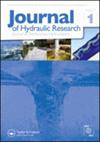Hybridizing FDM and FVM scheme of high-precision interface fast capture for mixed free-surface-pressurized flow in large cascade water delivery system
IF 1.7
3区 工程技术
Q3 ENGINEERING, CIVIL
引用次数: 0
Abstract
In recent years, China has been building several inter-basin water conveyance projects across mountains and deep valleys, leading to the extensive use of long tunnels and inverted siphons. The dynamics of mixed free-surface-pressurized flows are critical for tunnel design and operational safety. However, traditional numerical computation schemes cannot precisely and efficiently capture the pressure interface because the tunnel may be more than 70 km long. This study aims to develop a hybrid scheme that is as fast as the large-time-step Preissmann four-point scheme (FDM) and has the approximate interface accuracy of the finite volume method (FVM) by dynamic grid meshing. A dynamic mesh domain model (DM) is proposed by adopting an FVM mesh with a small time step to dynamically capture the interface and applying an FDM mesh with a large time step to improve computational efficiency. The results show that the method can simulate flow patterns, such as transcritical and pressurized flows, by ignoring the acceleration convection terms and capturing mixed free-surface-pressurized flows conveniently, accurately and efficiently. Furthermore, it can accelerate the computational speed of the transient mixed flow by a factor of approximately 100 when the target tunnel length exceeds 1200 m. The proposed scheme cannot capture the water hammer pressure because of the large time step. However, it can be effectively utilized in large cascade water delivery systems where the flow changes gradually.大型叶栅输水系统自由面压混合流高精度界面快速捕获的FDM和FVM混合方案
近年来,中国已经修建了几个跨流域的跨山深谷输水工程,导致了长隧道和倒虹吸管的广泛使用。自由面压混合流动的动力学对隧道设计和运行安全至关重要。然而,由于隧道长度可能超过70公里,传统的数值计算方案无法准确有效地捕捉压力界面。本研究旨在通过动态网格划分,开发一种与大时间步长Preissmann四点格式(FDM)速度相当且具有有限体积法(FVM)近似界面精度的混合格式。采用小时间步长FVM网格动态捕获接口,采用大时间步长FDM网格提高计算效率,提出了一种动态网格域模型。结果表明,该方法忽略了加速对流项,方便、准确、高效地捕获了自由表面-加压混合流动,可以模拟跨临界和加压流动等流型。当目标隧道长度超过1200 m时,该算法可将瞬态混合流的计算速度提高约100倍。该方法由于时间步长较大,无法捕捉水锤压力。但是,在流量逐渐变化的大型梯级给水系统中可以有效地利用它。
本文章由计算机程序翻译,如有差异,请以英文原文为准。
求助全文
约1分钟内获得全文
求助全文
来源期刊

Journal of Hydraulic Research
工程技术-工程:土木
CiteScore
4.90
自引率
4.30%
发文量
55
审稿时长
6.6 months
期刊介绍:
The Journal of Hydraulic Research (JHR) is the flagship journal of the International Association for Hydro-Environment Engineering and Research (IAHR). It publishes research papers in theoretical, experimental and computational hydraulics and fluid mechanics, particularly relating to rivers, lakes, estuaries, coasts, constructed waterways, and some internal flows such as pipe flows. To reflect current tendencies in water research, outcomes of interdisciplinary hydro-environment studies with a strong fluid mechanical component are especially invited. Although the preference is given to the fundamental issues, the papers focusing on important unconventional or emerging applications of broad interest are also welcome.
 求助内容:
求助内容: 应助结果提醒方式:
应助结果提醒方式:


